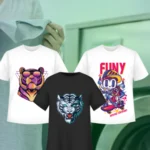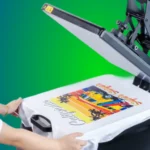How to Make DTF Transfers: A Step-by-Step Guide

Direct-to-film (DTF) transfers have transformed the printing industry, offering a game-changing method for creating vibrant, durable, and highly detailed custom designs. Whether you’re a business owner looking to produce custom DTF apparel, a hobbyist exploring creative projects, or a beginner eager to learn, this guide will walk you through the step-by-step process of making DTF transfers. From gathering essential materials like a DTF printer and transfer film to mastering the final application with a heat press, we’ll cover everything you need to know. Perfect for creating everything from team uniforms to personalized gifts, DTF transfers combine versatility, quality, and ease of use. Let’s dive in and unlock the potential of direct-to-film printing!
Table of Contents
ToggleWhat is a DTF Transfer?
DTF transfers are a cutting-edge printing technique that brings your designs to life with unmatched precision and vibrancy. Using a DTF printer, your artwork is printed onto a special transfer film, then coated with a powder adhesive to ensure it adheres perfectly to fabric. What sets direct-to-film printing apart is its versatility—it works seamlessly on a wide range of materials, including cotton, polyester, and blends, making it ideal for everything from custom apparel to promotional items. Known for its vibrant colors, exceptional durability, and flexibility, DTF transfers are a go-to solution for businesses, sports teams, and creatives looking to produce high-quality, long-lasting designs. Whether you’re crafting personalized t-shirts, hoodies, or unique merchandise, this method delivers professional results every time.
Why Choose a DTF Transfer?
DTF transfers stand out as a superior choice in the world of printing, offering a host of advantages over traditional methods. One of the biggest benefits is the exceptional quality they deliver—vibrant colors, sharp details, and the ability to print beautifully even on dark fabrics. This makes direct-to-film printing a versatile solution for a wide range of projects. The process is also highly cost-effective, particularly for small batches, making it accessible for businesses, hobbyists, and creatives alike. Beyond affordability, DTF transfers are incredibly durable and wash-resistant, ensuring your designs stay vibrant and intact over time. Their ease of application, thanks to the powder adhesive and heat press process, makes them ideal for creating custom DTF designs, whether for personalized apparel, promotional items, or unique gifts. From custom t-shirts to team uniforms, DTF transfers combine quality, durability, and versatility in one innovative solution.
Materials You’ll Need:
Before starting, gather the following materials:
-
- DTF printer
-
- Transfer film
-
- DTF powder adhesive
-
- Heat press
-
- Design software (e.g., Adobe Illustrator, CorelDRAW)
-
- Fabric or garment for transfer
-
- Protective gloves and mask (for handling powder)
Step By Step Process How to Make DTF Transfer
Gather Your Material
To get started with DTF transfers, gather all the essential tools and materials. A reliable DTF printer and high-quality transfer film are the foundation of the process, ensuring your designs come out sharp and professional. Don’t overlook the DTF powder adhesive, which plays a critical role in making sure your design adheres securely to the fabric. Having everything ready before you begin will streamline the process and help you achieve the best results.
Design Your Artwork
The next step is creating or finalizing your design using design software like Adobe Illustrator or CorelDRAW. For the best quality, ensure your artwork is high-resolution (300 DPI or higher). This is especially important for DTF transfers, as it guarantees crisp, clear prints with vibrant colors and fine details. Whether you’re designing custom t-shirts or promotional items, this step sets the stage for a flawless final product.
Print Your Design onto Transfer Film
Once your design is ready, load the transfer film into your DTF printer and print your artwork. Make sure your printer settings are optimized for direct-to-film printing to ensure the colors are vibrant and the details are sharp. This step is where your design truly comes to life, ready to be transferred onto fabric.
Apply the Adhesive Layer
After printing, evenly sprinkle DTF powder adhesive over the wet ink. Shake off any excess powder to avoid clumping, then cure it using a heat source. This step is crucial, as the powder adhesive ensures your design adheres firmly to the fabric during the transfer process, resulting in a durable and long-lasting finish.
Transfer the Design to the Fabric
Preheat your heat press to the recommended temperature (usually around 320°F). Place the fabric on the press, position the transfer film with the design facing down, and press for 10-15 seconds. The heat activates the adhesive, bonding the design to the fabric seamlessly. This step is where the magic happens, transforming your design into wearable art.
Peel Off the Transfer
Once the pressing is complete, carefully peel off the transfer film while it’s still warm. This reveals your vibrant design on the fabric. Be gentle during this step to avoid damaging the print, ensuring your DTF transfer looks professional and polished.
Post-Press the Fabric
For added durability, post-press the fabric for another 10-15 seconds. This final step ensures the design is fully set and enhances its wash resistance, making your custom DTF creations ready for everyday wear and tear.
What are the Common Problems of DTF Transfers
DTF printing can present challenges that affect your final results. Poor print quality often stems from incorrect printer settings or low-quality DTF ink. When colors appear dull, check your printer’s resolution and make sure you’re using high-quality DTF ink formulated for direct-to-film applications. Another frequent issue occurs during the heat press process as incorrect temperature or pressure results in transfers that don’t adhere properly.
Powder adhesive problems also affect many beginners working with DTF transfers. Too much or too little powder causes uneven adhesion, while improperly cured adhesive leads to weak bonds. The heat press transfer step requires precise timing and temperature control. Rushing often results in incomplete transfers or designs that wash out. Using incompatible inkjet printer equipment with DTF transfers leads to frustrating results and wasted materials. Proper storage is crucial as dust affects adhesion during application, impacting your custom DTF transfers quality.
Tips for Success DTF Transfers
Achieving excellent results with DTF printing requires attention to detail throughout the entire process. Investing in quality equipment like a dedicated DTF printer with appropriate ink produces better results than modifying a standard inkjet printer. Maintain a clean, dust-free workspace to get the best print quality.
Temperature and timing control are crucial for successful heat press transfers. Always preheat your heat press to 320°F and maintain consistent pressure. The heat press process should be smooth and continuous without lifting. When working with custom DTF transfers, allow proper cooling time before peeling as this ensures the adhesive bonds correctly with fabric.
Proper preparation significantly impacts success. Use direct to film techniques that optimize ink saturation for vibrant colors. Apply powder adhesive quickly while ink is wet, distributing evenly across the design. Shake off excess powder to prevent texture issues. Store transfer film in cool, dry conditions and use DTF transfers within recommended timeframes for high quality DTF transfers results.
Conclusion
Creating DTF transfers is a simple yet highly effective process that delivers professional-quality results every time. With the right tools—like a reliable DTF printer, high-quality transfer film, and DTF powder adhesive—you can produce vibrant, durable designs that work on virtually any fabric. Whether you’re crafting custom DTF apparel for your business, creating personalized gifts, or experimenting with creative projects, this step-by-step guide ensures you achieve stunning results. Ready to take your designs to the next level? Explore our DTF gang sheet builder to unlock even more creative possibilities, allowing you to combine multiple designs onto a single sheet for maximum efficiency and versatility. Start your direct-to-film printing journey today and bring your ideas to life with ease and confidence!
FAQs
How do I make my own DTF transfers?
To conduct a transfer from DTF, you need a DTF printer, the right transfer film, DTF powder adhesive and a heat press. Design your graphic, print with DTF ink, wet powder adhesive, and heat cure. Use a heat press transfer process, 320°F press for 10-15 seconds to customize DTF transfers onto T-shirts and other fabric items for excellent results.
What is needed to print DTF transfers?
Essential items you need are a DTF printer, DTF ink, transfer film, DTF powder adhesive, and heat press. Design software and protective equipment are also necessary. DTF direct to film process needs these materials, you can’t get high-quality DTF transfer with regular inkjet printer supplies.
Can you use a regular printer for DTF transfers?
No, regular inkjet printer models cannot produce DTF transfers. DTF printing requires specialized DTF printers designed for DTF ink and transfer film. Traditional printers do not have ink delivery systems suitable for the DTF Direct to film process, therefore leading to low quality prints as well as failure for the heat press transfers.
What are DTF transfers made of?
DTF transfers consist of transfer film, DTF ink, and DTF powder adhesive. These components work together during the heat press process to create durable custom DTF transfers that maintain quality through washing and regular use.
How to make DTF transfers with a sublimation printer?
You cannot make true DTF transfers with sublimation printers, as they use different inks and processes. Sublimation uses dye-based inks, while DTF printing requires pigment-based DTF ink and powder adhesive. For authentic high quality DTF transfers, use equipment designed specifically for the DTF direct to film process.



